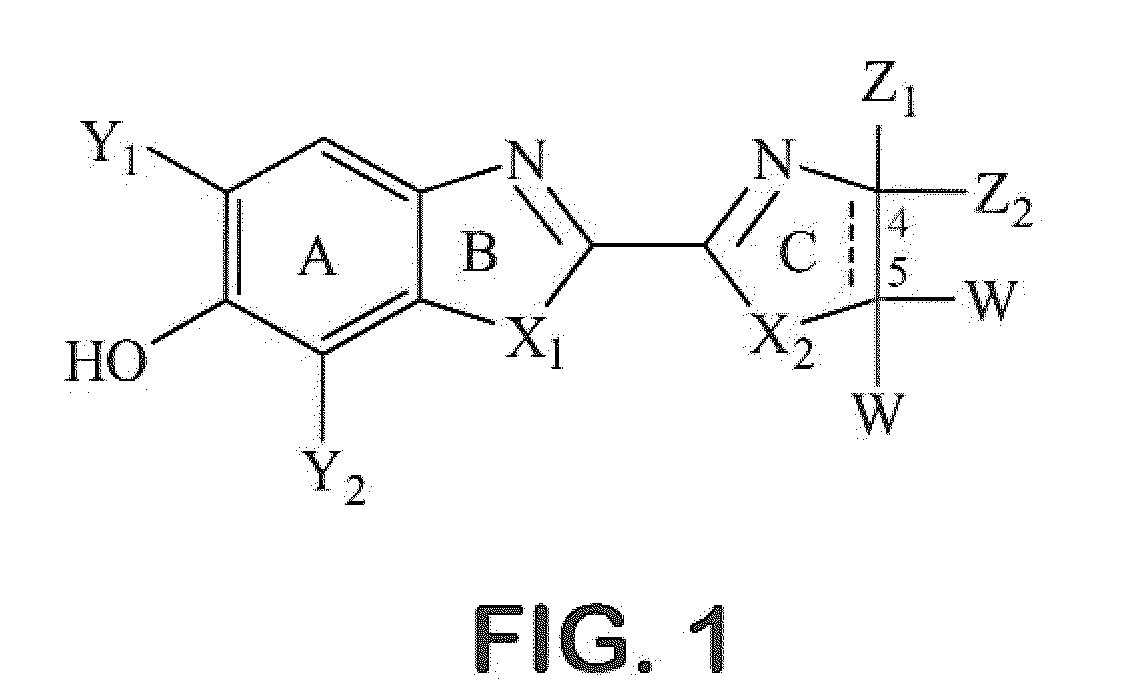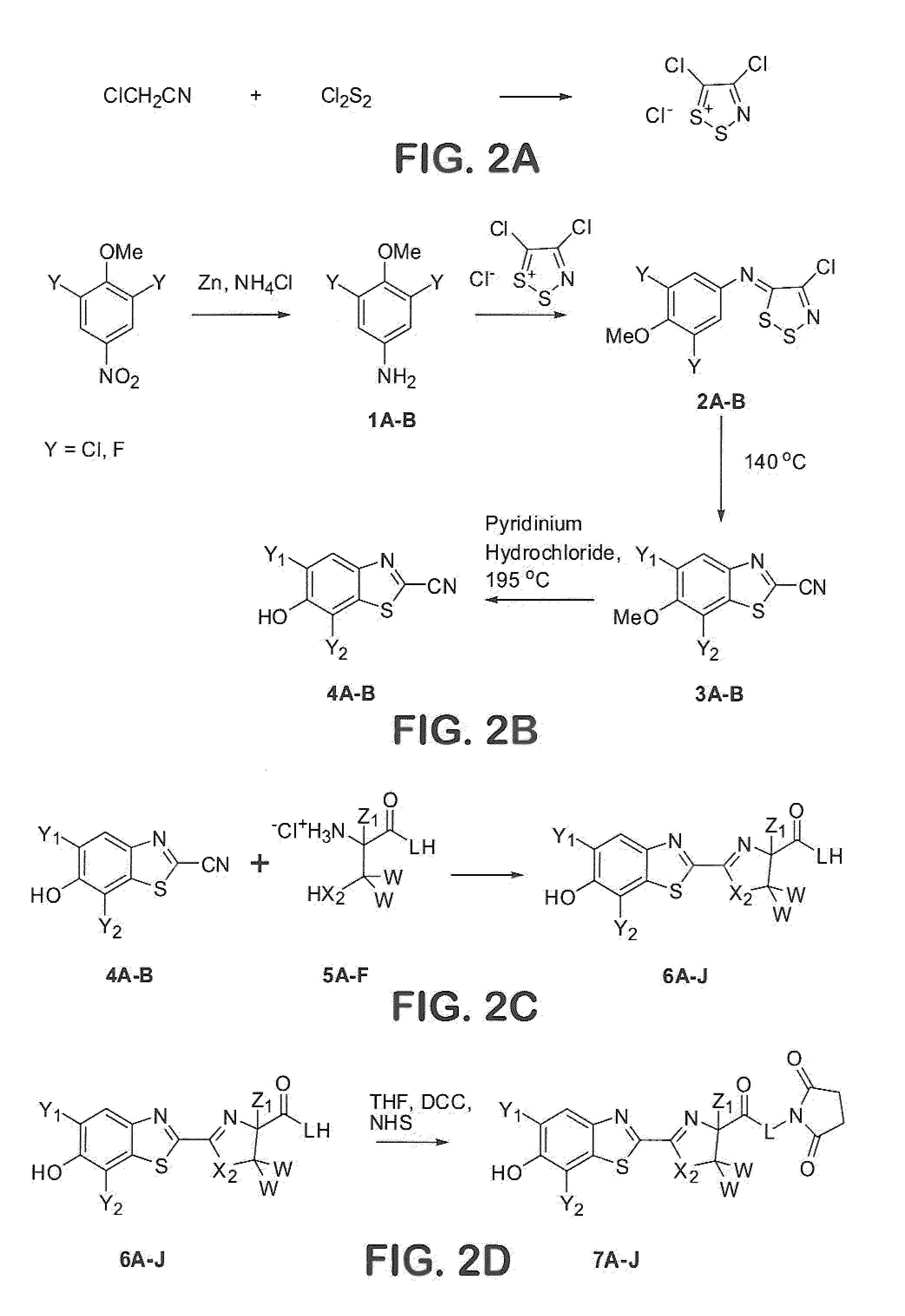Novel Fluorescent Dyes and Uses Thereof
a fluorescent dye and fluorescent technology, applied in the field of fluorescent dyes, can solve the problem that the use of compounds having a structure similar cannot be proved
- Summary
- Abstract
- Description
- Claims
- Application Information
AI Technical Summary
Benefits of technology
Problems solved by technology
Method used
Image
Examples
example 1
[0174]The following example provides a description of a general method for the synthesis of dihalo derivatives of firefly luciferin and their respective NHS esters.
1. Preparation of Appel Salt
[0175]
[0176]A 500-mL round-bottomed flask was charged with chloroacetonitrile (20 mL), sulfur monochloride (120 mL), and CH2Cl2 (110 mL) under argon. The reaction stirred under argon for 3 days while a brown precipitate formed. The precipitate was collected by suction filtration and washed with CH2Cl2 (300 mL) and hexanes (300 mL). The washed solid was vacuum dried to give the product as a brown solid (75% yield).
2. Preparation of 2-Cyanobenzothiazoles
[0177]The following procedure is for the preparation of 5,7-dichloro-6-hydroxy-2-cyanobenzothiazole. The preparation of 5,7-difluoro-6-hydroxy-2-cyanobenzothiazole followed the same procedure with very similar results.
[0178]A 5-L round-bottomed flask was charged with 1,3-dichloro-2-methoxynitrobenzene (0.33 moles), ammonium chloride (3.3 moles), a...
example 2
[0278]The following example provides the description of a method for conjugating the fluorescent dyes of the invention to an antibody molecule.
[0279]In a typical experiment, antibody conjugates of Luciferin derivatives are prepared as follows. The antibody of interest is prepared in 50 mM Borate pH 9.0 buffer at 4 mg / ml. The dye reagent is dissolved in anhydrous DMSO to give a concentration of 5 mg / ml. Predetermined amounts of the dye in DMSO are slowly added to the antibody solution with mixing. The reaction is incubated at room temperature for 60 minutes. Thereafter the reaction is quenched with addition glycyl glycine (200 molar excess to the dye used) solution at 75 mg / ml in PBS, 2 mM EDTA. The dye-antibody conjugate is separated desalting on a Sephadex G-50 column equilibrated in PBS. The elution is monitored for 280 nm absorbance and the antibody containing band is collected from the column. The degree of substitution (F / P Value) is determined by measuring absorbance values fo...
example 3
[0281]The following example provides method for using the antibody-dye conjugates in flow cytometry.
Flow Analysis
[0282]Optimum quantities (determined separately by titration) of various compositions of antibody-dye conjugates of the invention were independently combined with a biological specimen containing whole blood (00.1 mL), incubated for 10-15 minutes, processed using the standard procedure using VersaLyse™ lysing reagent, and analyzed using a flow cytometer. Briefly, the treated biological specimen was combined with the VersaLyse™ reagent / 0.2% Formaldehyde (1 mL) for 10 minutes, spinning down the treated specimen, aspirating the supernatant, resuspending the pellet in PBS (2 mL) spinning down the cell suspension and resuspending the pellet in PBS / 0.1% formaldehyde (1 mL) for analysis. The lymphocyte population was selected by flow cytometry based on forward and side scatter characteristics. Subpopulations were identified using specific monoclonal antibodies. Fluorescence sign...
PUM
| Property | Measurement | Unit |
|---|---|---|
| Wavelength | aaaaa | aaaaa |
| Wavelength | aaaaa | aaaaa |
| Length | aaaaa | aaaaa |
Abstract
Description
Claims
Application Information
 Login to View More
Login to View More - R&D
- Intellectual Property
- Life Sciences
- Materials
- Tech Scout
- Unparalleled Data Quality
- Higher Quality Content
- 60% Fewer Hallucinations
Browse by: Latest US Patents, China's latest patents, Technical Efficacy Thesaurus, Application Domain, Technology Topic, Popular Technical Reports.
© 2025 PatSnap. All rights reserved.Legal|Privacy policy|Modern Slavery Act Transparency Statement|Sitemap|About US| Contact US: help@patsnap.com



